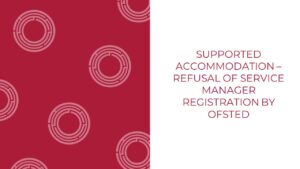As we move into a less restrictive post-COVID-19 world, providers will want to be vigilant about infection, prevention and control (“IPC”) measures.
The Government has announced numerous changes in the last year which greatly reduced the burden on providers when it came to IPC measures, including removing regular mandatory COVID-19 testing and facemask requirements in care settings.
In this article I will cover what the most up to date Government guidance says regarding IPC measures and the impact this will have on care providers in a post-COVID-19 world.
Government Guidance
The COVID-19 specific guidance was withdrawn and has since been replaced by a COVID-19 supplement which was last updated on 23 December 2022.
The most recent updates have been made in the areas of outbreak management, staff testing, and PPE (i.e. mask) requirements.
Of particular interest is the removal of the requirement to wear facemasks in care settings at all times. For the vast majority of the pandemic, facemasks were the deemed to be the first and best defense against the spread and contraction of COVID-19.
Key Areas for Provider Focus
- Outbreak Management
First and foremost, outbreak management is much less stringent and has given providers a great deal of discretion to decide when and what outbreak measures are necessary and appropriate in their homes. The guidance has also redefined outbreak as, “two or more positive or clinically suspected linked cases of COVID-19, within the same setting within a 14-day period,” and further goes on to state that, “If an outbreak is suspected, the care home should undertake a risk assessment as soon as possible to determine if the situation can be considered an outbreak and if outbreak management measures are needed. The provider should inform the HPT or other local partner of a suspected outbreak, but they are not required to wait for advice from the HPT (or other relevant local partner) should they feel able to initiate the risk assessment independently.”
Regarding the risk assessments themselves, the guidance states that they must consider whether:
- there is a known source of infection
- the initial individual with suspected or confirmed COVID-19 may have infected others while in the setting. For example, if the individual was in the setting while they were likely to be infectious (up to 2 days before symptoms onset or a positive test, and up to 10 days after)
- the initial individual had contact with the other individual or individuals with suspected or confirmed COVID-19 while they were likely to have been infectious
- the initial individual may have picked up the infection from the setting. This may be possible if the individual was in the setting during their incubation period (up to 14 days prior to symptom onset and/or a positive test)
- there are any factors which may increase the risk of transmission occurring in the setting
In the event of a confirmed outbreak, outbreak testing is still recommended.
The guidance has provided a clear outline as to what providers need to be on the lookout for, but has ultimately left the decision on what will require such an assessment up to the providers themselves.
- Staff
Where staff are concerned, providers have seen a burden eased as well. While vaccination is no longer mandated, it is still strongly recommended and providers should still encourage and assist all staff to receive both doses of the COVID-19 vaccination along with boosters wherever possible. PPE and facemasks are also still strongly recommended, but no longer mandated.
Testing and limiting movement of staff has also moved to an ad-hoc, risk based approach largely at the discretion of the individual provider. Again, measures which were previously the golden standard if IPC are now put forward as strong recommendations of best practice.
Where staff display symptoms they should test. Free testing has been provided for symptomatic testing to care homes for both staff and residents.
The testing regime is currently two lateral flow tests 48 hours apart. If either test is positive, staff are advised not to report to work until they receive two consecutive negative lateral flow test results taken at least 24 hours apart, they feel well, and they do not have a high temperature. The next test after a positive result should not be taken until at least day 5.
Notably, this guidance does not mention anything about monetary compensation for staff who are unable to work due to a positive COVID-19 result. According to guidance on statutory sick pay, no staff member is entitled to SSP unless they are too ill to work. It seems that it will be up to providers to determine how they best manage staff who test positive for COVID-19 but are not too ill to actually perform their work duties.
- Visiting Arrangements
Perhaps the most controversial area of COVID-19 regulation, visiting arrangements will be a key to preventing and controlling the spread of COVID-19 and any other infectious disease in care settings.
The current guidance states that each resident, at minimum, should be allowed to have at least one visitor at a time in the home in order to uphold every person’s right to private and family life.
The guidance outlines a number of precautions for visitors to take, including following the home’s IPC policies, and not visiting if they feel unwell, even if they have received a negative COVID-19 test and/or are vaccinated.
Further, residents cannot be required to test after high risk visits out of the home, nor can they be required to isolate.
Impact
Ultimately the burden has been eased on providers to ensure that there are COVID-19 specific prevention measures in place. For example, the following is no longer required of providers:
- Regular testing of residents and staff;
- Testing of visitors;
- Staff vaccination;
- Ensuring staff and visitors wear facemasks at all times;
- Cohorting of residents and staff in the event of an outbreak.
This means less expense and time, in theory, for providers, however there is still the risk of infection from COVID-19 so providers should not fall into a false sense of security simply because the mandatory requirements have changed.
The CQC will still be looking to ensure that all IPC measures are fit for purpose, so while COVID-19 may not have specific, legally mandated requirements, it does not mean that those practices can simply be forgotten and IPC measures will be held to the same standard as pre-COVID-19 times.
As for the areas of focus mentioned above, providers will want to be especially vigilant of the following:
- Outbreak management – ensure that the policies and risk assessments in place take an extra cautious approach. While many of the requirements that were legally mandated have been removed it does not mean that these will be deemed irrelevant in future when providers are being inspected. It is likely that many of the previously required COVID-19 measures will now be deemed as best practice and thus something that the CQC can still potentially used to downgrade ratings if providers are not making every effort to ensure a robust IPC policy is in place.
- Staff – providers will want to take an extremely cautious approach with staff who are off work due to COVID-19 related illness. A prudent IPC policy and thorough risk assessments will be necessary alongside a genuine attitude of supporting staff to ensure that they can continue and return to work safely.
- Visiting Arrangements – it will be better for providers to take precautions when it comes to allowing visitors rather than scrapping all limitations. While a person’s right to private and family life is vital to their experience in a care setting, so is their overall health. Providers should continue to put the overall health needs of all their service user above all else when developing visiting guidance in their homes.
The easing of these extra, COVID-19 specific measures may seem like a relief to many providers, however it is imperative they still remain vigilant to the signs of infectious diseases, especially respiratory ones, and take a cautious approach to prevention and control of outbreaks within their homes.







